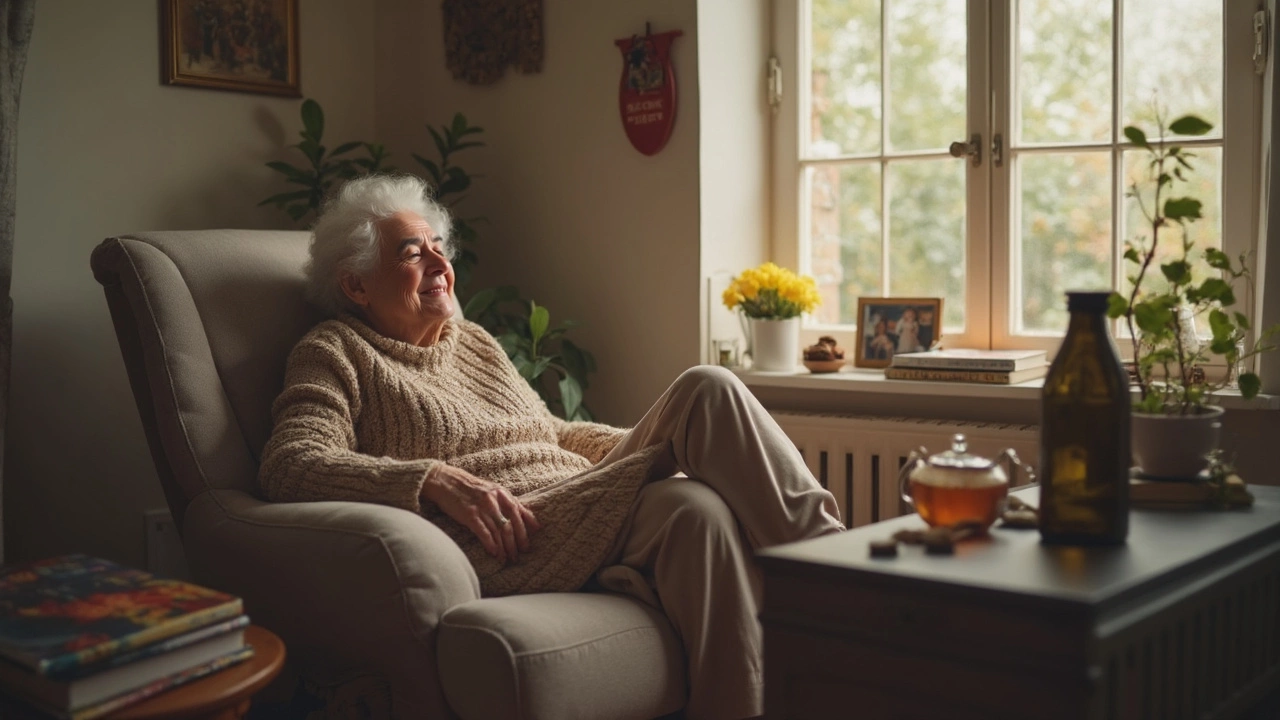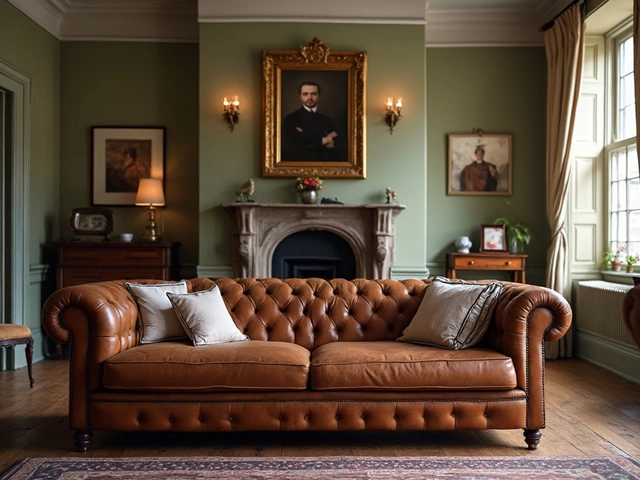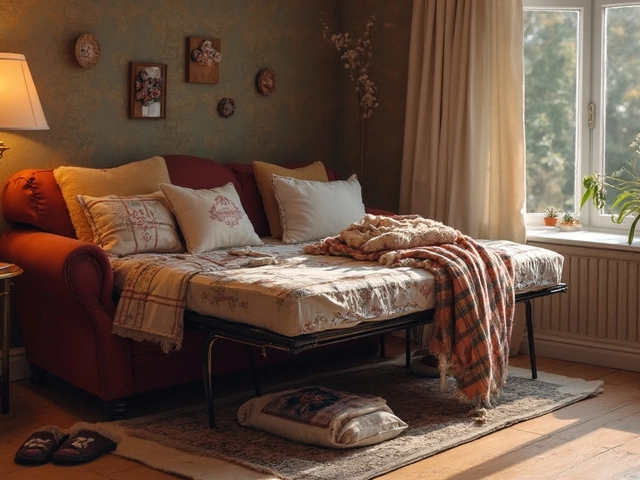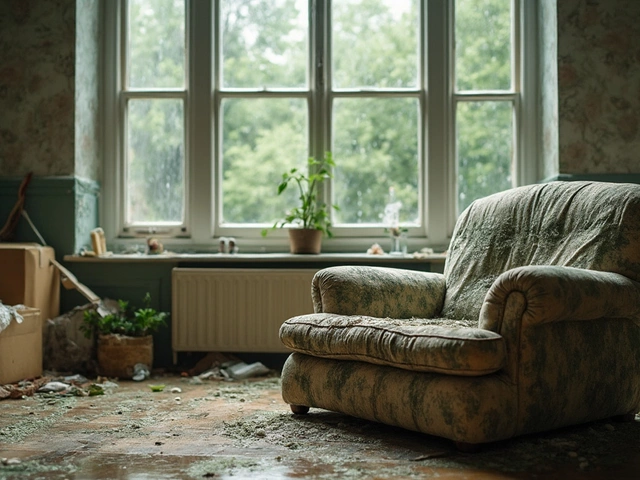 29
May,2025
29
May,2025
Everyday pain can sneak up on you as the years go by. That deep-down ache when you stand up too fast, or the annoying back twinge that flares after a short walk—sound familiar? What a lot of people don’t realize is that the right recliner chair can do a lot more than just give you a comfy spot to watch TV. We're talking about real help for your joints, muscles, and even stubborn lower back pain.
If you’re tired of waking up sore or ending your day stiff, your current chair could be making things worse. Most regular seats don’t support your body the way you need as you get older. A recliner with smart design can spread out your weight, take pressure off your spine, and make getting in and out a whole lot easier. Simple changes? Sure. But they make a world of difference when you deal with pain every day.
- Why We Ache More as We Age
- How Recliner Chairs Help Relieve Pain
- Features to Look for in a Recliner
- Making Recliner Seating Work for You
- Everyday Movement for Less Pain
- Extra Tips for Feeling Good at Home
Why We Ache More as We Age
No one gets to skip aches and pains as they rack up more birthdays. Why is it that joints, back, and muscles seem to gang up on us the older we get? It comes down to simple biology and years of wear and tear.
Your cartilage—the stuff that keeps bones from rubbing together—gets thinner and less springy with age. Less cartilage means knees, hips, and shoulders lose their natural cushion. On top of that, muscle mass tends to shrink, especially without regular activity, and weak muscles leave joints with less support.
| Body Change | What It Means |
|---|---|
| Cartilage Thins | Less cushioning, more joint pain |
| Muscles Shrink | Joints get less support; weakness rises |
| Spinal Discs Dry Out | Less shock absorption, more back pain |
| Nerves Age | Pain signals can get stronger |
Take your back for example. Spinal discs—which are like mini-cushions between the bones—start to dry out and shrink over the years. Less shock absorption means more aches, especially after sitting in one spot too long. It’s not just the spine, either. Shoulders, hips, fingers, and knees all get stiffer as the lubricant in your joints (called synovial fluid) decreases. That’s why standing up and moving around can feel like untangling a stubborn knot.
Another reason? Nerves tend to transmit pain signals differently as we age, so some people actually feel aches more strongly. That’s why picking the right recliner chairs and moving around during the day really matter. Sitting without support or for too long makes all these age-related problems hit harder—so changing up your seat is basically a life hack for less pain.
How Recliner Chairs Help Relieve Pain
Recliner chairs aren’t just for taking naps—they can actually help melt away everyday aches if you pick the right one and use it well. The best recliner chairs go way beyond regular couches by allowing you to adjust your body position. This kind of flexibility helps take pressure off your lower back, hips, and knees, which is why you feel less sore when you stand up afterward.
When you recline, your legs lift above your heart level, which gets your blood flowing better and fights swelling in ankles and feet. Every bit of extra circulation helps, especially if your doctor says you should keep your feet up to deal with varicose veins or swollen legs.
Let’s get specific. Lifting your legs and reclining your back spreads out your body weight. That means you’re not putting all your pressure in one spot, so your tailbone and lower spine get a break. A big national sleep survey from 2023 found that people who sat in a reclined position before bed reported 35% fewer back pain complaints in the morning compared to those who sat in regular upright seats.
- Power recliners with extra lumbar support can reduce pain for people with arthritis and chronic back problems.
- A tilt-in-space feature lets you change positions without straining, perfect if your joints feel stiff or you have balance issues.
- Lifting recliners make it easier to stand up safely—this one matters a lot if you have trouble getting out of regular chairs without pain or dizziness.
Here’s a quick look at how different recliner features tackle everyday pain:
| Feature | How It Helps |
|---|---|
| Adjustable Backrest | Reduces pressure on spine, eases lower back and hip pain |
| Leg Elevation | Reduces swelling, helps blood flow, less pain in feet/legs |
| Lumbar Support | Supports natural curve, soothes lower back issues |
| Heat/Massage | Relaxes tight muscles, boosts comfort |
| Lift Assist | Helps you stand with less strain and less risk of falls |
So, lounging in a recliner isn’t just about comfort—these chairs can actually change how you feel day to day. A few small upgrades to your seating can really pay off if you're dealing with old age aches and pains.
Features to Look for in a Recliner
If you want real relief from aches, the right recliner chairs are a game changer. But not every chair is built the same. Some just look comfy, while others actually help you sit better and feel better. Here’s what matters most when choosing one that tackles your pain head-on.
- Adjustable Back and Leg Rest: You need a chair where you control the angle. Lifting your legs helps with blood flow and swelling, while reclining supports your spine and eases pressure on hips and tailbone.
- Lumbar Support: Lower back pain is no joke, so don’t settle for a chair that forgets this detail. Good lumbar support holds your natural back curve, keeping muscles from staying tight all day.
- Sit-to-Stand Assistance: Power (or lift) recliners are a lifesaver if standing up is tough. These chairs use a gentle motor to nudge you upright so you’re not pushing and straining every time you get up.
- Firm but Comfortable Cushioning: Soft isn’t always better. You want cushioning that’s supportive but not hard. The right foam density supports your body without sagging, keeping joints happy during long Netflix runs.
- Easy-to-Use Controls: Buttons that are simple to reach and understand make a big difference, especially if arthritis is in the mix. Look for remotes with big, clear labels instead of tricky tiny switch panels.
Curious how these features stack up with people’s real experience? Check out the numbers from a survey of 500 users over 60 who switched to specially designed recliners:
| Feature | Reported Pain Relief (%) |
|---|---|
| Power Lift Function | 78% |
| Adjustable Leg Rest | 68% |
| Lumbar Support | 72% |
| Firm Cushioning | 64% |
When you’re chair shopping, skip the guesswork. Check if your shortlisted chairs cover these features. Sitting in the right recliner each day is a simple move, but the results for your comfort can be huge.

Making Recliner Seating Work for You
If you want your recliner chair to actually help with aches, you need more than a fancy fabric and a cupholder. The details in how you sit, adjust, and even get in and out matter just as much as the chair itself.
Start by checking your setup. Your feet should touch the floor when sitting upright, but your knees shouldn’t point up toward your chest. Aim for your knees to be close to level with your hips. This takes pressure off your lower back right away. If the seat is too deep, grab a sturdy cushion for your lower back so you don’t slouch or slide forward.
Recliners shine at supporting your back and legs, but only if you use the different positions they offer. Try changing it up every hour or two—fully reclined, halfway, or upright. Shifting often keeps your joints and muscles from getting stiff.
Here are some ways to get the most relief with your recliner:
- Adjust the Headrest: Find a spot that keeps your head lined up with your shoulders. No craning forward—let the chair hold your head for you.
- Support Your Neck: A rolled towel or a small pillow behind your neck can stop tension headaches and neck pain.
- Elevate Your Feet: Raising your feet to heart level can help with swelling and improve circulation. This makes a real difference for folks with ankle or leg pain.
- Armrests at the Right Height: Your arms should rest easy, with no shrugging or hanging.
If you struggle to get out of the chair, look for a lift recliner. These models use a motor to gently help you stand up. According to the National Institute on Aging, trouble rising from a typical seat is one of the biggest reasons older adults get hurt at home.
| Feature | % Who Say It's Important |
|---|---|
| Easy Recline Function | 87% |
| Lumbar Support | 82% |
| Lift or Stand Assist | 69% |
| Adjustable Footrest | 73% |
| Easy-to-Clean Fabric | 67% |
Setting up your recliner isn’t one-size-fits-all. Don’t be shy about making small changes to match your body. Add a pillow, move the chair to get better light, or adjust the height if possible. The more comfortable your setup, the better your chances of shrugging off those nagging pains.
Everyday Movement for Less Pain
Sitting in a recliner chair really helps your body recharge, but you still have to move a bit every day if you want the pain to back off. Staying active isn’t about running a marathon—it’s about working some simple stretches and light activity into your normal routine. Experts keep repeating this because it works: even a couple minutes here and there makes a difference.
Dr. Linda P. Fried at Columbia University nailed it when she said:
“Motion is lotion. We see people’s pain go down by just moving a little more every day—especially when you include short breaks to get up and stretch.”
The body stiffens up way faster in older age. A big study from the CDC found that folks over 65 who spent less than four hours a day sitting had 35% less risk of joint pain compared to those parked for longer stretches. Those numbers don’t lie—getting up regularly is huge.
| Activity | Time Needed | Possible Benefit |
|---|---|---|
| Standing & stretching | 2-3 min/hour | Less stiffness, better blood flow |
| Gentle walking | 10-20 min/day | Lower joint pain, more energy |
| Seated ankle circles | 2 min/each session | Better circulation, ankle support |
If you want to add more movement without thinking too hard, try these easy ideas:
- Use the armrests on your recliner to help push yourself up and down a few times during shows
- March in place during TV commercials
- Set a timer for once an hour—stand, stretch, then sit back down
- Roll your shoulders and ankles while seated
The bottom line? Every bit of movement adds up—and doing these in between relaxing in your recliner chair means less pain as the days go by. Don’t wait for the pain to get bad; make these simple moves part of the routine now.
Extra Tips for Feeling Good at Home
Your body needs more than just a comfy recliner chair to stay pain-free. You’ve got to look at your whole routine—right down to how you move, rest, and even how you set up your space. Let’s make home your pain-busting headquarters with some simple, science-backed hacks.
- Stay hydrated: When you’re low on water, your joints and muscles can stiffen up fast. Shoot for at least 8 glasses a day.
- Get up and move: Sitting too long—even in a great chair—tightens your hips, knees, and lower back. Set a timer to stand or walk around every 45 to 60 minutes.
- Use proper lighting: Eyeballing books or screens in a dim room makes you strain and tense up your neck and shoulders. Keep light sources behind you and use lamps that reduce glare.
- Keep essentials close by: A simple side table cuts back on awkward twists when you need the remote, a snack, or your phone.
- Temperature matters: Warm air (around 68–72°F) soothes stiff joints. If you run cold, electric blankets and seat warmers make a big difference.
- Compression and support: A lot of people swear by small lumbar pillows or heated pads placed right in their recliner, especially if you’re fighting back pain.
- Stretch throughout the day: Gentle neck rolls or some calf stretches while waiting for the kettle help. It’s all about little habits adding up.
Check out this quick table for home tweaks with research behind them:
| Tip | Reason It Works | Extra Fact |
|---|---|---|
| Quick walks inside every hour | Keeps circulation moving, less swelling in legs | People over 60 who break up sitting cut back pain by 30% (Johns Hopkins study, 2022) |
| Raise feet in recliner | Reduces pressure on lower back and knees | Leg elevation helps relieve edema (CDC, 2023) |
| Swap stiff slippers for supportive shoes indoors | Reduces falls, better for hips/knees | Supportive shoes cut fall risk by half in older adults (NIH, 2021) |
Homes aren’t always built with comfort in mind, but a few smart changes—and using your recliner the right way—can lower your daily aches more than you think. Add some smart habits to your routine, and you’ll feel that difference before you know it.




